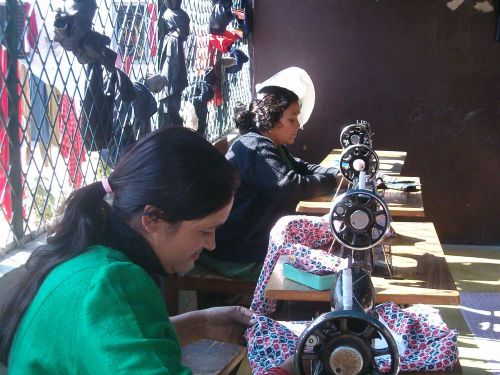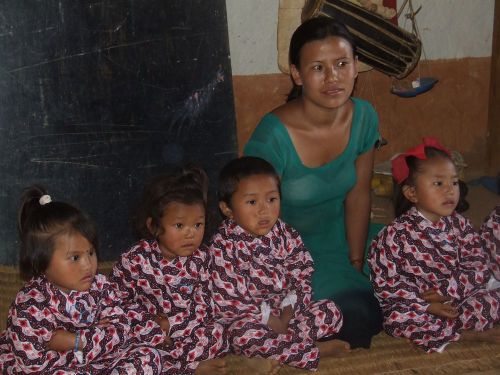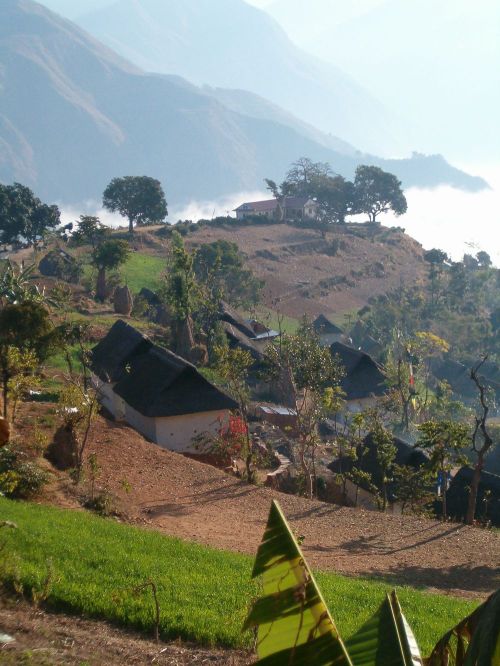 It was a very good experiences and a nice project we did in 2006-2007 in the Central Jail (Female section) in Kathmandu. We provided sewing machines to more than 40 prisoner women, technical training, management training and legal assistance. We supplied them with all materials useful to produce garments for their family and children. The second step was to tailor boto (the tradition child dress) which we distributed in the Bal Bikas (Early Childhood Dev. Centers) we created in Timal (Kavre) enrolling more than 800 children. All children got a sort of uniform which was a good help for the family.
It was a very good experiences and a nice project we did in 2006-2007 in the Central Jail (Female section) in Kathmandu. We provided sewing machines to more than 40 prisoner women, technical training, management training and legal assistance. We supplied them with all materials useful to produce garments for their family and children. The second step was to tailor boto (the tradition child dress) which we distributed in the Bal Bikas (Early Childhood Dev. Centers) we created in Timal (Kavre) enrolling more than 800 children. All children got a sort of uniform which was a good help for the family.
The last step should be to start production for the local market directed to foreign tourist wih the idea to channel garments to international fair trade market. The Women Tailor Group after one year of working and training were able to produce some nice garments from which we had selling agreements with local shops.
All was stopped by the donor (CCS Italia INGO) with no reasons in 2007. Even the brand we studied was put in a corner as well the works and hopes of the women involved.
This project was a namuna (sample) which could be extended, as our intention, to other jails in Nepal,  and we did it in coordination with Jail authorities. The objective were to assure a little income to the prisoners, give them job opportunities out of the jail and a something to do during detention in order to avoid violence and bad attitudes.
and we did it in coordination with Jail authorities. The objective were to assure a little income to the prisoners, give them job opportunities out of the jail and a something to do during detention in order to avoid violence and bad attitudes.
To create opportunities and hope (it was the brand for the Inmates Cooperative) is the only way to help prisoners during detention and to help them to be reintroduced in normal life.
A recent survey showed that the situation in Nepali jails is deteriorating form many point of view and few activities are running to help the prisoners which are detained in over crowded structures.
This research shows that 38% of the prisoners it had surveyed had access to drugs even behind the bars in different parts of the country including the Central Jail, Bhadra Bandi Griha, Bhadra Mahila Bandi Griha, Dillibazaar Jail, Nakkhu Prison, Biratnagar Prison, Pokhara Prison and Birgunj Prison
Total of 351 prisoners living in the eight jails were surveyed and 15 per cent of the respondents were women.
 Of the people who use drugs in the jails, 20 per cent said they use marijuana, 20 per cent brown sugar, 10 per cent injections and the rest 50 per cent said they use many kinds of drugs.
Of the people who use drugs in the jails, 20 per cent said they use marijuana, 20 per cent brown sugar, 10 per cent injections and the rest 50 per cent said they use many kinds of drugs.
The survey stated that 50 per cent of the Injecting Drug Users (IDUs) in the jails share same needle. Half of the IDUs in jails had visited treatment and rehabilitation centres and hospitals at least once while the another half had never gone to either a hospital or any drop-in centre.
Legal assistance, income generating activities might be the way to give a reasons of life to these people.
Tag Archives: ccs nepal
Working in the jails
Filed under aid industry, nepal
When people moves
We always worked in cooperation with people and community to increase capacity. Here two success stories.
Sixty families of freed Kamaiya Tharus and internally displaced have turned the Janahit Mahakali Community Forest into a model for grassroots forest management. In a forest north of the East West Highway, where trees were depleting due to massive deforestation by wood mafia and erosion, the community has planted over 8,000 bamboo, timber and hardwood trees since 2004. Locals have also benefitted by producing more than a hundred tonnes of ginger. This unique system of agroforestry has raised living standards, while conserving forests. The community has donated Rs 100,000 to the nearby Udaya Higher Secondary School to provide free education for students from the ninth to twelfth grade, and Rs 40,000 to Kanchanpur Campus all from the sale of forest products. Members of the community can buy oxen on interest-free loans, flood control embankments have been built, VDC roads have been gravelled and a new child welfare centre built.
The chairman of the group adds that one of the biggest achievements has been the protection of the forest and wildlife. “We haven’t just protected trees,” he says, “we have seen more deer than ever before and even tigers and leopards have returned.”
In 2006 we started the electrification project in Timal and set TCRECA (a local cooperative) in order to mobilise community and manage the local grid which now is covering 3 VDCs and in construction for other 4. We help the local cooperative to born and now they are proceeding by themselves.
No wonder, as many as 65 communities across 38 districts are engaged in the scheme. They are not only self-reliant but also act as watchdog against pilferage of energy. As per the Community Electrification Distribution by-laws 2060, the programme follows a 20-80 policy (community contributes 20 per cent of the total project cost and the government picks up the tab for the rest) . Over the years, the programme has worked wonders. It has promoted public participation, encouraged community management and also harnessed technical and managerial skills of the rural folks.
Here is a case in point to bolster this argument:
Of a total budget of Rs 20 million, South Lalitpur Rural Electrification Cooperatives contributed Rs 4.7 million in the first phase.
Over the past six years, the programme has lit up 2,500 households in 14 remote Village Development Committees.
“Record reveals that very few households had access to electricity before the scheme was launched. However, we had to incur technical losses, thanks to the rugged terrain, elaborate network for transmission lines and high voltage transformers,” said Govinda Bajagain, managing coordinator of the cooperatives. The initiative has transformed the local economy. It now helps to run mills, furniture factories and computer-aided schools. “We have deliberately kept the profit margins low. We buy power at Rs 3.60 Kwh and sell it at Rs 4 Kwh,” he added.
Filed under nepal
Dal Nepal: buon anno ai Sostenitori italiani di CCS Italia
Before Chisthmas 2009, CCS Nepal expressed criticism on some methods and practices of the italian INGO which they were collaborating since 2003. New management and people have been appointed both in Nepal and Italy from the middle of 2007 so many activities have been reduced or cutted. We give an abstract of the letter and a table which compare the activities done in 2006 and those in 2008.
Cari Amici
Prima di tutto, ringraziamo I sostenitori italiani che dal 2003 stanno aiutando I nostri bambini e comunità nel Distretto di Kavre, I migliori auguri per le festività di Natale e del nuovo anno.
CCS Nepal, formata da gente di Kavre, iniziò nel 2003 tutte le attività per contribuire a educazione e salute in Nepal, grazie a migliaia di Sostenitori italiani.
Come abbiamo scritto nei posts precedenti stiamo ancora discutendo con I responsabili di CCS Italia INGO il budget per il 2009 e come far proseguire I nostri progetti.
Dal 2007 I fondi sono costantemente diminuiti e così l’aiuto e le opportunità che eravamo in grado di dare ai bambini e alle comunità di Kavre, come si vede dalla tavola che compara le attività nel 2006 e nel 2008.
Come siamo preoccupati per l’elevato aumento delle spese di gestione dell’ufficio di Kathmandu di CCS Italia che è passato da 4 a 22 funzionari per gestire meno attività rispetto al 2006. Ciò significa che le spese di gestione (stipendi, rents, attrezzature, macchine, etc.) sono cresciute da euro 43.000 in 2006 a 153.000 in 2008. Ciò ha gravemente ridotto I fondi per I progetti e I beneficiari.
Vogliamo estendere queste preoccupazioni ai Sostenitori italiani.
Thanks for all
The Staff of CCS Nepal NGO
activitiescompare TABLE ACTIVITIES 2006 COMPARED TO 2008 (tAVOLA DI COMPARAZIONE ATTIVITA’ 2006 e 2008)
Dear Friends
First of all we thank a lot the Italian sponsors which since 2003 are helping our children and community in Kavre District and best wishes for your for Christmas and the End of the year holidays.
CCS Nepal, formed by local people of Kavre, established 5 years ago all activities related to education and health in Nepal thanks to the help of thousand Italian sponsors.
From 2007 our budget and activities were severely reduced as well as the help and opportunities we were able to give to children and community in Kavre as appears in the comparing the activities in the table below which resume the documents already published.
As well as we are worried about the huge increase of running expenditures in CCS Italy office in Kathmandu which passed from 4 people to 22 managing less activities. It means that the running expenditures (salaries, equipments, cars, rents, etc.) raised from Euro 43.000 in 2006 to 153.000 in 2008, this has severely reduced the fund for the projects and beneficiaries.
We extend our concern to Italian sponsors.
CCS Nepal NGO staff
Filed under nepal












